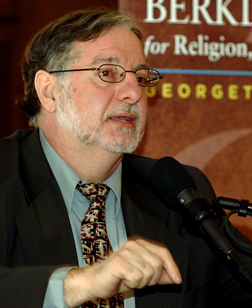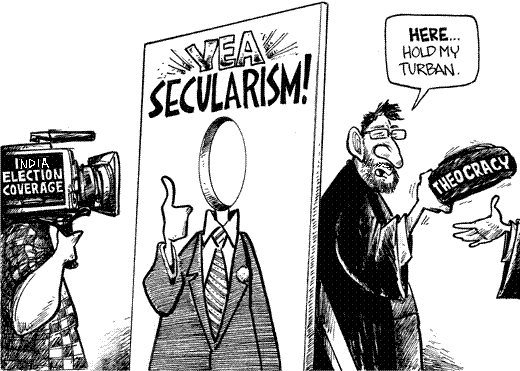On 27 August 2013, the Jesuit think-tank UCSIA inside Antwerp University (Universitair Centrum Sint-Ignatius Antwerpen) hosted, as part of its series on “Religion, Culture and Society”, a lecture by the sociologist of religion, José Casanova of Georgetown University. He spoke with a heavy Spanish accent about “Types of Secular States and Regimes of Religious Pluralism: USA, India, China”.
 Casanova noted a veritable paradigm shift among his colleagues. We live in an era of globalization of both the religions and secularism, and under an increasing familiarity with an Increasing diversity of religions. The scholars are now admitting that their secularization thesis (that modernization would lead to a decrease in religiosity everywhere) is not correct. Religion has adapted and made many gains even in formerly secularized circles and societies. We live in a postsecular world. He also saw a shift in methodology: religious scholarship is increasingly interdisciplinary and studies religion and the secular in their mutual relation.
Casanova noted a veritable paradigm shift among his colleagues. We live in an era of globalization of both the religions and secularism, and under an increasing familiarity with an Increasing diversity of religions. The scholars are now admitting that their secularization thesis (that modernization would lead to a decrease in religiosity everywhere) is not correct. Religion has adapted and made many gains even in formerly secularized circles and societies. We live in a postsecular world. He also saw a shift in methodology: religious scholarship is increasingly interdisciplinary and studies religion and the secular in their mutual relation.
There are two types of secular state: assertive or aggressive secularism in order to free politics from religion, as in France and now in China; and secularism as the dis- or non-establishing of a state religion, striving for neutrality between the different denominations, as in the US and to a large extent in India.
In Europe, there were since ca. four centuries mostly confessional states under the principle “Cuius region, illius et religio”, i.e. “to whom the region belongs, his is also the religion”. In a certain sense, this arrangement has continued after the population has largely secularized. This means that while all West-European countries have a large “unchurching”, no country has crossed the line from having Catholicism as the state religion to being in majority Protestant; or vice versa. Many Europeans associate modernization with secularization. So, there has been an unchurching but no conversion. In America, by contrast, many unchurched people joined a religion (or as they call it in the US, a religious “denomination”) after finding a place in American society, and associated it with the progress that America would bring.
On China and India, he introduced himself as a dilettante, a mere sociologist. Let us reassure him: nothing to worry about, with his sociological glasses on he would not stand out in a typical South-Asian Studies department. There, Sanskrit and classical studies are neglected and shunned (because deemed fostering “Hindu fundamentalism”) while the focus has shifted to studying social groups oppressing or oppressed by caste and other so-called evils of Hindu society. He proposed to concentrate on religion.
In mainland China, the official policy has been a rejection of religion (“smash temples and build schools”). In the Marxist scheme of things, religion is part of the childhood of mankind, which we have outgrown in this age of science. Even before China became Communist, the modernizing processes were deemed to be hampered by traditions and religion.
These were considered “feudal” vices. Zongjiao, “religion”, is a 19th-century neologism, and strictly denotes a sectarian group. With the reforms of Deng Xiaoping and since, the toleration of religion has gradually increased. Now religion is used to some extent for harmonious social development. Half the Chinese books on religion are less than ten years old. Chinese folk religion or minxin (short for minjian xinyang) , “people’s faith” is the most popular religion in China, in which most people participate to some extent, e.g. by celebrating Chinese New Year.
However, the five religions recognized by the state are Daoism, Buddhism, Islam, Catholicism and Protestantism; others, including native sects such as the “evil sect” of Falungong, are illegal. However, these five are not really equal, for Daoism and Buddhism have a weaker sense of membership (and hence exclusivity and militancy) than the other three. Only 10% of the population is member of a religion. Members of the ruling Communist Party are required to be atheist.
India, by contrast, chose for a mobilization of the religions, as the annihilation of religion was deemed impossible. Religion permeates the whole society and, like in Northern Ireland, religious identity proves very resilient: even a declared atheist, depending on his provenance, is deemed a “Hindu atheist” or a “Muslim atheist”. According to Rajeev Bhargava, India’s secularism is no copy of Western secularism, based on keeping or creating a distance in the relation between religion and the state. Instead, it embraces religion, but tries to keep neutrality between the different religions. Except that it makes a  distinction between the majority and the minorities, which get privileged in the Constitution, the laws and political practice, in order to protect them from the majority. Thus, a parliamentary majority involving non-Hindus imposed reforms on Hinduism but does not touch Muslim law. Even Casanova, unlike most Westerners, was aware that India discriminates against the majority.
distinction between the majority and the minorities, which get privileged in the Constitution, the laws and political practice, in order to protect them from the majority. Thus, a parliamentary majority involving non-Hindus imposed reforms on Hinduism but does not touch Muslim law. Even Casanova, unlike most Westerners, was aware that India discriminates against the majority.
In fact, India is not a secular state at all. Casanova is a well-meaning but unforewarned Westerner swallowing and reproducing what he is spoon-fed by Bhargava. The latter is a cunning representative of India’s rulers, who has an interest in pretending that India practices “secularism”, and that anything that might seem unsecular to Westerners is due not to a defect in India’s secularism but to the observers being Westerners who don’t understand India’s unique approach to secularism. Well, he would, wouldn’t he?
India does not satisfy a minimum definition of a secular state (which means Bhargava and all the other self-described secularists are wrong). This does not follow from Indian secularism being Indian as against Western, but from it being secularism. First of all, a minimum condition of a secular state is that all citizens have to abide by the same laws. In India, by contrast, Hindus, Muslims, Christians and Parsis have separate law codes, at least for marriage, family matters and inheritance. Most parties allow this constitutional non-secularism.
The only major party that promises real secularism, i.e. a Common Civil Code, is the Hindu nationalist BJP, which is (paradoxically and counterfactually) accused of being “a threat to Indian secularism”. Secondly, the anti-majority discrimination is not “secular”, and by definition it is not secular in the sense of “neutral” between different worldviews. It i s inconceivable that the American Constitution would prohibit a Protestant citizen from becoming President, or any other office. To apply an example really on the statute books in India, it is inconceivable that the American Constitution would allow the religious minorities to set up state-subsidized faith schools but withhold this right from Protestants, forcing Protestants to redefine themselves as a non-Protestant religious minority, the way the Arya Samaj and the Ramakrishna Mission have gone to court to get themselves recognized as non-Hindu minorities.
s inconceivable that the American Constitution would prohibit a Protestant citizen from becoming President, or any other office. To apply an example really on the statute books in India, it is inconceivable that the American Constitution would allow the religious minorities to set up state-subsidized faith schools but withhold this right from Protestants, forcing Protestants to redefine themselves as a non-Protestant religious minority, the way the Arya Samaj and the Ramakrishna Mission have gone to court to get themselves recognized as non-Hindu minorities.
It may also interest some people that Casanova reaffirmed the observation that conversion is the most revolutionary event, and not only demographic. Among those who are left behind as loyal members of their parental religion, it triggers a crisis as if their central beliefs were overturned. Well, Mahatma Gandhi would have approved, for in Indian society such as it is, conversion cuts families or communities down the middle.
For this reason, he was dead against conversion. His opinion that it should be outlawed, however, was overruled by the secularists who took power upon decolonization, for in the Constitution they gave a guarantee of “freedom of religion”, including “propagation” (i.e. missionary activity). This too was a serious discrimination, for implying “propagation” in the free practice of religion accords with the historical experience of Christians and Muslims but not of Hindus or Parsis.
Even though in Western circles some travelling Gurus have advertised their “path”, Hindus traditionally don’t really propagate, and many communities don’t accept converts. For Parsis, any form of conversion into their religion is excluded. So the freedom to propagate does not count for them. It was only given a place in the Constitution to satisfy Christians and Muslims, the groups served by the secularists.































1 Comment